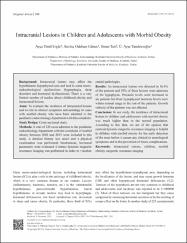| dc.contributor.author | Ergur, Ayca Torel | |
| dc.contributor.author | Gunes, Sevinc Odabasi | |
| dc.contributor.author | Tan, Sinan | |
| dc.contributor.author | Tandircioglu, U. Ayse | |
| dc.date.accessioned | 2020-06-25T18:23:08Z | |
| dc.date.available | 2020-06-25T18:23:08Z | |
| dc.date.issued | 2017 | |
| dc.identifier.citation | Ergür A. T., Güneş S. O., Tan S., Tandırcıoğlu Ü. A. (2017). Intracranial Lesions in Children and Adolescents with Morbid Obesity. Balkan Medical Journal, 34(2), 108 - 112. | en_US |
| dc.identifier.issn | 2146-3123 | |
| dc.identifier.issn | 2146-3131 | |
| dc.identifier.uri | https://doi.org/10.4274/balkanmedj.2015.1541 | |
| dc.identifier.uri | https://hdl.handle.net/20.500.12587/7017 | |
| dc.description | WOS: 000400660600003 | en_US |
| dc.description | PubMed: 28418336 | en_US |
| dc.description.abstract | Background: Intracranial lesions may affect the hypothalamo-hypophyseal axis and lead to some neuroendocrinological dysfunctions (hyperphagia, sleep disorders and hormonal dysfunctions). There is a very limited number of studies about childhood obesity and intracranial lesions. Aims: To evaluate the incidence of intracranial lesions and its role in clinical symptoms and aetiology in cases with morbid obesity who have been admitted to the paediatric endocrinology department with this complaint. Study Design: Cross-sectional study. Methods: A total of 120 cases admitted to the paediatric endocrinology department with the complaint of morbid obesity between 2002 and 2015 were included in this study. A detailed history was taken and a physical examination was performed; biochemical, hormonal parameters were evaluated. Contrast dynamic magnetic resonance imaging was performed in order to visualize cranial pathologies. Results: An intracranial lesions was detected in 16.6% of the patients and 55% of these lesions were adenoma of the hypophysis. Prolactin levels were increased in six patients but front hypophyseal hormone levels were within normal range in the rest of the patients. Growth velocity of the patients was not affected. Conclusion: In our study, the incidence of intracranial lesions in children and adolescents with morbid obesity was much higher than in the normal population. According to this data, we are of the opinion that contrast dynamic magnetic resonance imaging is helpful in children with morbid obesity for the early detection of the mass before it causes any clinical or neurological symptoms and in the prevention of future complications. | en_US |
| dc.language.iso | eng | en_US |
| dc.publisher | Galenos Yayincilik | en_US |
| dc.relation.isversionof | 10.4274/balkanmedj.2015.1541 | en_US |
| dc.rights | info:eu-repo/semantics/openAccess | en_US |
| dc.subject | Intracranial lesions | en_US |
| dc.subject | children | en_US |
| dc.subject | morbid obesity | en_US |
| dc.subject | magnetic resonance imaging | en_US |
| dc.title | Intracranial Lesions in Children and Adolescents with Morbid Obesity | en_US |
| dc.type | article | en_US |
| dc.contributor.department | Kırıkkale Üniversitesi | en_US |
| dc.identifier.volume | 34 | en_US |
| dc.identifier.issue | 2 | en_US |
| dc.identifier.startpage | 108 | en_US |
| dc.identifier.endpage | 112 | en_US |
| dc.relation.journal | Balkan Medical Journal | en_US |
| dc.relation.publicationcategory | Makale - Uluslararası Hakemli Dergi - Kurum Öğretim Elemanı | en_US |
















